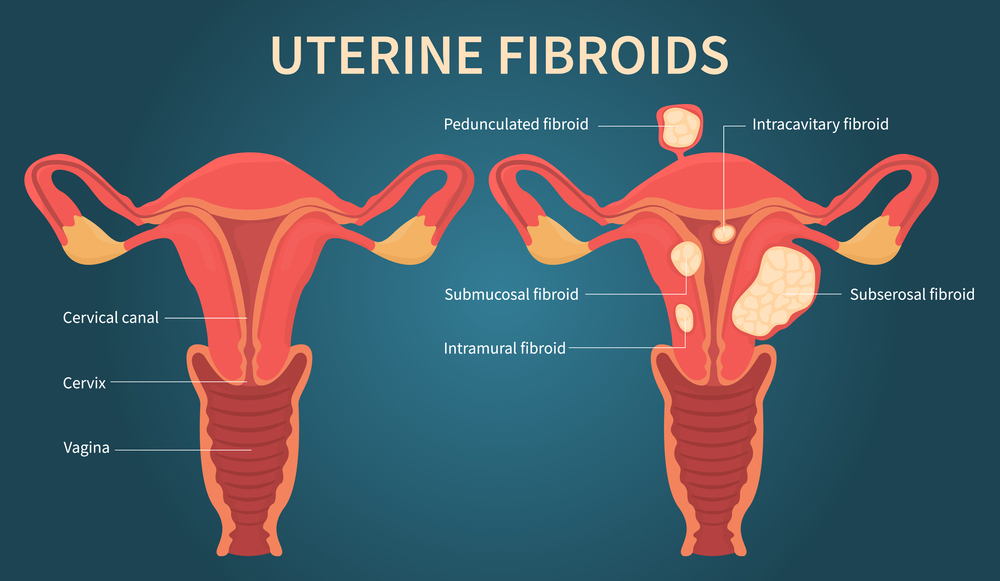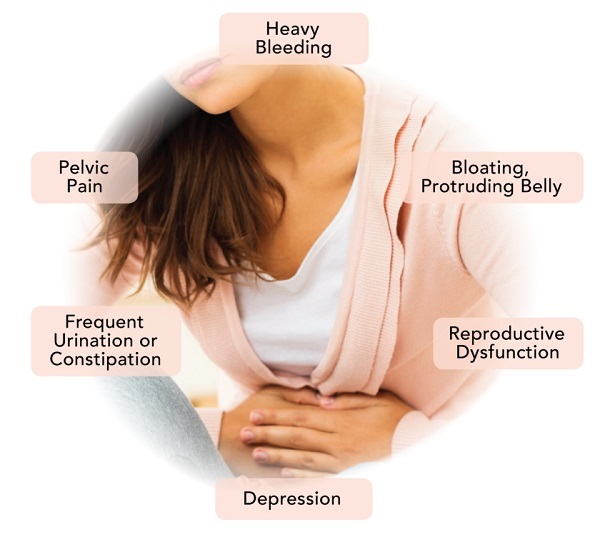Uterine Fibroids are unusual growths that develop inside or on a woman’s uterus. Sometimes these tumors can become quite big and cause sharp abdominal pain and heavy flow during periods. In some cases, they produce no signs or symptoms at all. The growths are typically harmless or noncancerous.
Fibroids are also known as
- leiomyomas
- uterine myomas
- fibromas
- myomas
The Office on Women’s Health has reported that almost 80 percent of women are affected by the age of 50. But, most women don’t have any symptoms and may never even find out that they have fibroids.

Who is at higher risk for Fibroids?
Women are at higher risk for acquiring fibroids if they have any of these risk factors:
- pregnancy
- age of 30 or older
- a high body weight
- a family history of fibroids
- African-American
Symptoms of Fibroids

- Prolonged periods
- Bleeding between periods
- Pelvic pain
- Constant urination
- Lower back pain
- Pain during intercourse
- Difficulty getting pregnant
Your symptoms will also depend on the number of tumors you have and their location and size.
If your tumor is tiny or you’re undergoing menopause, you may not have witnessed any symptoms. Fibroids may shrink during and even after menopause. Women going through menopause are feeling a drop in their levels of progesterone and estrogen -hormones that stimulate fibroid growth.
Causes
- Many fibroids include changes in genes that vary from those in healthy uterine muscle cells.
- Estrogen and progesterone appear to encourage the growth of fibroids.
- Fibroids carry more estrogen and progesterone receptors than healthy uterine muscle cells do. Fibroids usually shrink after menopause because of a decrease in hormone production.
- Substances that support the body maintain tissues, for example, insulin-like growth factor, may influence fibroid growth.
- ECM (Extracellular matrix ) is the element that makes cells stick together. ECM is increased in fibroids and hence makes them fibrous. It also stores growth factors and creates biological changes in the cells themselves.
Treatment
Most fibroids do not require treatment. They usually disappear after menopause.
If fibroids cause uncomfortable symptoms, various medical treatments can help.
1] Medication
The first course of treatment for fibroids is Medication. Here are some possible medications in detail.
- Nonsteroidal anti-inflammatory drugs
Nonsteroidal anti-inflammatory drugs, for example, ibuprofen, can decrease fibroid pain but do not reduce bleeding.
- Hormonal birth control
Oral contraceptives can control the ovulation cycle and can help lessen the amount of bleeding during periods. A low dose of hormonal birth control will not make fibroids grow.
People use progesterone intrauterine devices or progesterone-like injections.
2] Surgery
Severe fibroids may not react to more conventional treatment options. In these instances, Surgery is the best option.
- Hysterectomy
It is the partial or complete removal of the uterus. This can treat extremely large fibroids or even excessive bleeding. Total hysterectomy can stop the return of fibroids.
If a surgeon removes the ovaries and fallopian tubes, side effects can include decreased libido and early menopause.
- Myomectomy
Removal of the fibroids from the muscular wall of the uterus is called Myomectomy. It helps people who want to have children.
Those with big fibroids or fibroids found in particular parts of the uterus may not profit from this type of Surgery.
- Endometrial ablation
Removing the uterine lining can help if fibroids are found near the inner surface of the uterus. This may be an efficient alternative to a hysterectomy for people with fibroids.
- Uterine fibroid embolization
Cutting the blood supply to the area contracts the fibroid. Led by fluoroscopic X-ray imaging, the doctor injects a chemical through a catheter inside the arteries, which supplies blood to any fibroids.
However, this method is not advised for women during pregnancy or for those who want to have children.
Furthermore, this is not a suitable treatment method for all types of fibroid.
3] Lifestyle changes
Keeping a moderate weight by regular exercise and eating a healthy diet may help moderate estrogen levels, which can help decrease fibroids.
Do’s and Dont’s
DO’S
- Load up on fresh fruits and vegetables
- Keep an eye on your blood pressure
- Manage your stress level
- Make yourself comfortable
- Discuss with your doctor before you experiment with any kind of supplement.
DONT’S
- Don’t eat a diet full of processed foods, red meats, and high-fat dairy
- Don’t skip your workouts.
- Don’t overdo it on the sugar
- Don’t smoke
Side-effects and risks after treatment
There can be risks. Medications do have side effects, and few may not be good for you. Speak to your healthcare provider about the medications you are taking for other medical conditions and your medical history before beginning with a new medication.
There are also risks associated with the surgical treatment of fibroids. Any surgery will place you at risk of infection, bleeding, or any natural risks because of Surgery and anesthesia. An extra risk of fibroid removal surgery includes future pregnancies. Some surgical options can stop future pregnancies. Myomectomy is a procedure that will only remove the fibroids, allowing for future pregnancies. Though, women who have had a myomectomy may need to deliver future babies by Caesarean section.
Uterine fibroids are a normal condition that several women face during their life. In few cases, fibroids are small and hence don’t cause any symptoms at all. But at other times, fibroids can cause uncomfortable symptoms. Fibroids can indeed be treated, and, usually, your symptoms can be improved.
Frequently Asked Question and Answers
1. Can fibroids be treated without surgery ?
According to WebMD the non surgical treatment of fibroids is possible using medication or through Uterine Fibroid Embolization (UFE).
